Procedure, Example Solved Problem | Operations Research - Solution of assignment problems (Hungarian Method) | 12th Business Maths and Statistics : Chapter 10 : Operations Research
Chapter: 12th Business Maths and Statistics : Chapter 10 : Operations Research
Solution of assignment problems (Hungarian Method)
Solution
of assignment problems (Hungarian Method)
First check whether the
number of rows is equal to the numbers of columns, if it is so, the assignment
problem is said to be balanced.
Step :1 Choose the least element
in each row and subtract it from all the elements of that row.
Step :2 Choose the least element
in each column and subtract it from all the elements of that column.
Step 2 has to be performed from the table obtained in step 1.
Step:3 Check whether there is
atleast one zero in each row and each column and make an assignment as
follows.
(i) Examine the rows
successively until a row with exactly one zero is found. Mark that zero by ![]() , that means an assignment is made there . Cross ( ├Ś) all other zeros in its column. Continue this until all the rows
have been examined.
, that means an assignment is made there . Cross ( ├Ś) all other zeros in its column. Continue this until all the rows
have been examined.
(ii) Examine the columns
successively until a columns with exactly one zero is found. Mark that zero by ![]()
![]() , that means an assignment is made there .
Cross ( ├Ś ) all other zeros in its row. Continue this until all the columns
have been examined
, that means an assignment is made there .
Cross ( ├Ś ) all other zeros in its row. Continue this until all the columns
have been examined
Step :4 If each row and each
column contains exactly one assignment, then the solution is optimal.
Example
10.7
Solve the following
assignment problem. Cell values represent cost of assigning job A, B, C and D
to the machines I, II, III and IV.
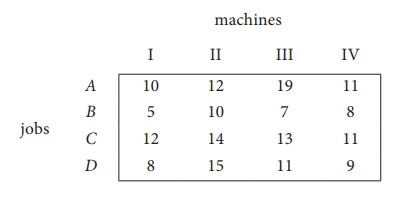
Solution:
Here the number of rows
and columns are equal.
Ōł┤
The given assignment problem is balanced. Now let us find the solution.
Step 1: Select a smallest element in each row and subtract this from all
the elements in its row.
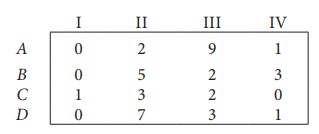
Look for atleast one
zero in each row and each column.Otherwise go to step 2.
Step 2: Select the smallest element in each column and subtract this from
all the elements in its column.
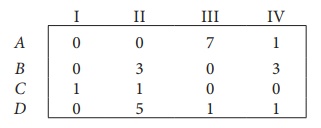
Since each row and
column contains atleast one zero, assignments can be made.
Step 3 (Assignment):
Examine the rows with
exactly one zero. First three rows contain more than one zero. Go to row D.
There is exactly one zero. Mark that zero by ![]() (i.e) job D is
assigned to machine I. Mark other zeros in its column by ├Ś .
(i.e) job D is
assigned to machine I. Mark other zeros in its column by ├Ś .
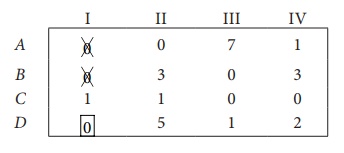
Step 4: Now examine the columns with exactly one zero. Already there is
an assignment in column I. Go to the column II. There is exactly one zero. Mark
that zero by ![]() . Mark other zeros in its rowby ├Ś .
. Mark other zeros in its rowby ├Ś .
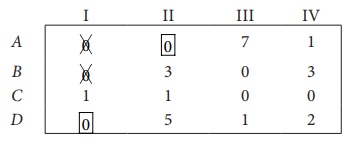
Column III contains more
than one zero. Therefore proceed to Column IV, there is exactly one zero. Mark
that zero by ![]() . Mark other zeros in its row by ├Ś .
. Mark other zeros in its row by ├Ś .
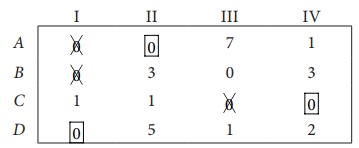
Step 5: Again examine the rows. Row B contains exactly one zero. Mark
that zero by ![]() .
.
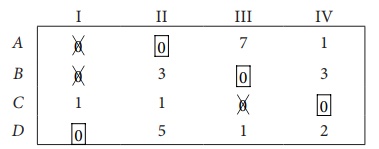
Thus all the four
assignments have been made. The optimal assignment schedule and total cost is
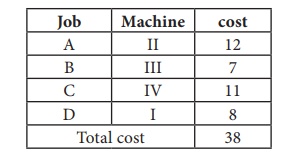
The optimal assignment
(minimum) cost
= Ōé╣ 38
Example
10.8
Consider the problem of
assigning five jobs to five persons. The assignment costs are given as follows.
Determine the optimum assignment schedule.
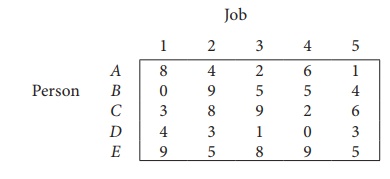
Solution:
Here the number of rows
and columns are equal.
Ōł┤
The given assignment problem is balanced.
Now let us find the
solution.
Step 1: Select a smallest element in each row and subtract this from all
the elements in its row.
The cost matrix of the
given assignment problem is
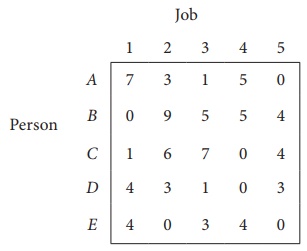
Column 3 contains no
zero. Go to Step 2.
Step 2: Select the smallest element in each column and subtract this from
all the elements in its column.
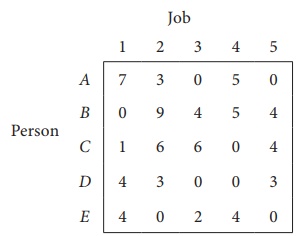
Since each row and
column contains atleast one zero, assignments can be made.
Step 3 (Assignment):
Examine the rows with
exactly one zero. Row B contains exactly one zero. Mark that zero by ![]() (i.e) PersonB is assigned to Job 1. Mark other zeros in its column by ├Ś .
(i.e) PersonB is assigned to Job 1. Mark other zeros in its column by ├Ś .
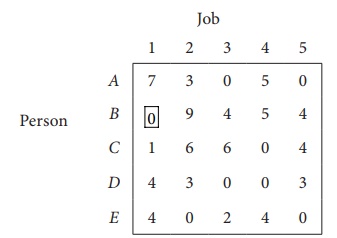
Now, Row C contains
exactly one zero. Mark that zero by ![]() . Mark other zeros in its
column by ├Ś .
. Mark other zeros in its
column by ├Ś .

Now, Row D contains
exactly one zero. Mark that zero by ![]() . Mark other zeros in its
column by ├Ś .
. Mark other zeros in its
column by ├Ś .
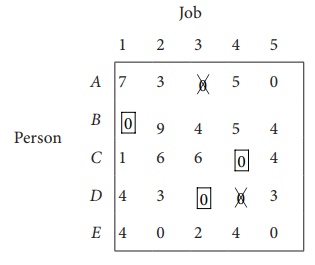
Row E contains more than
one zero, now proceed column wise. In column 1, there is an assignment. Go to
column 2. There is exactly one zero. Mark that zero by ![]() . Mark
other zeros in its row by ├Ś .
. Mark
other zeros in its row by ├Ś .
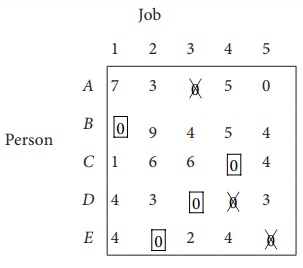
There is an assignment
in Column 3 and column 4. Go to Column 5. There is exactly one zero. Mark that
zero by ![]() . Mark other zeros in its row by ├Ś .
. Mark other zeros in its row by ├Ś .
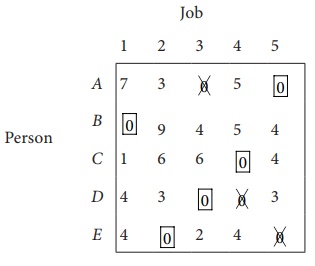
Thus all the five
assignments have been made. The Optimal assignment schedule and total cost is
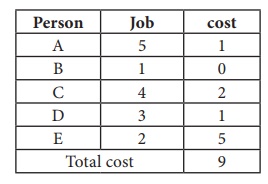
The optimal assignment
(minimum) cost = ` 9
Example
10.9
Solve the following
assignment problem.
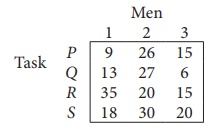
Solution:
Since the number of
columns is less than the number of rows, given assignment problem is unbalanced
one. To balance it , introduce a dummy column with all the entries zero. The
revised assignment problem is
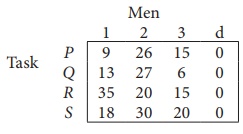
Here only 3 tasks can be
assigned to 3 men.
Step 1: is not necessary, since each row contains zero entry. Go to Step
2.
Step 2 :
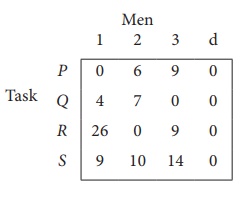
Step 3 (Assignment) :
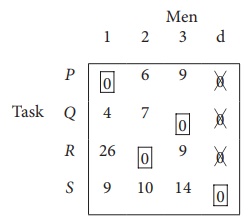
Since each row and each
columncontains exactly one assignment,all the three men have been assigned a
task. But task S is not assigned to any Man. The optimal assignment schedule
and total cost is
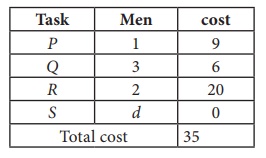
The optimal assignment
(minimum) cost = Ōé╣ 35
Related Topics